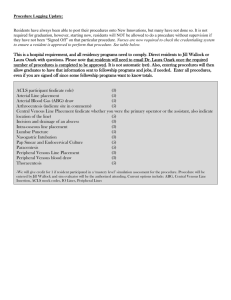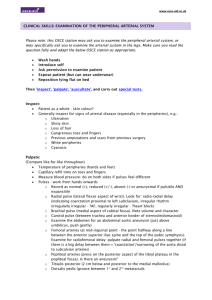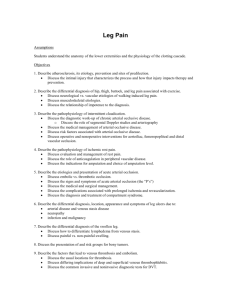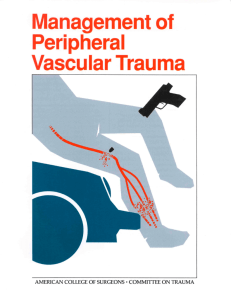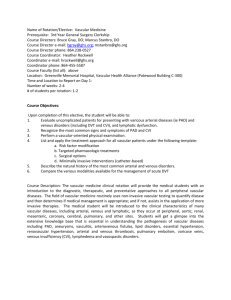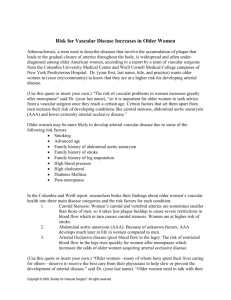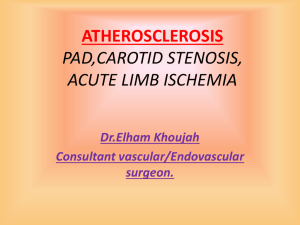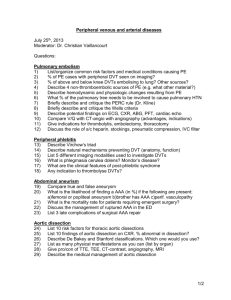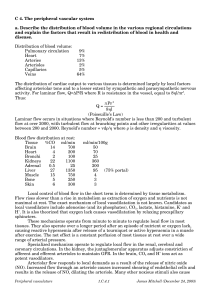varicose
advertisement
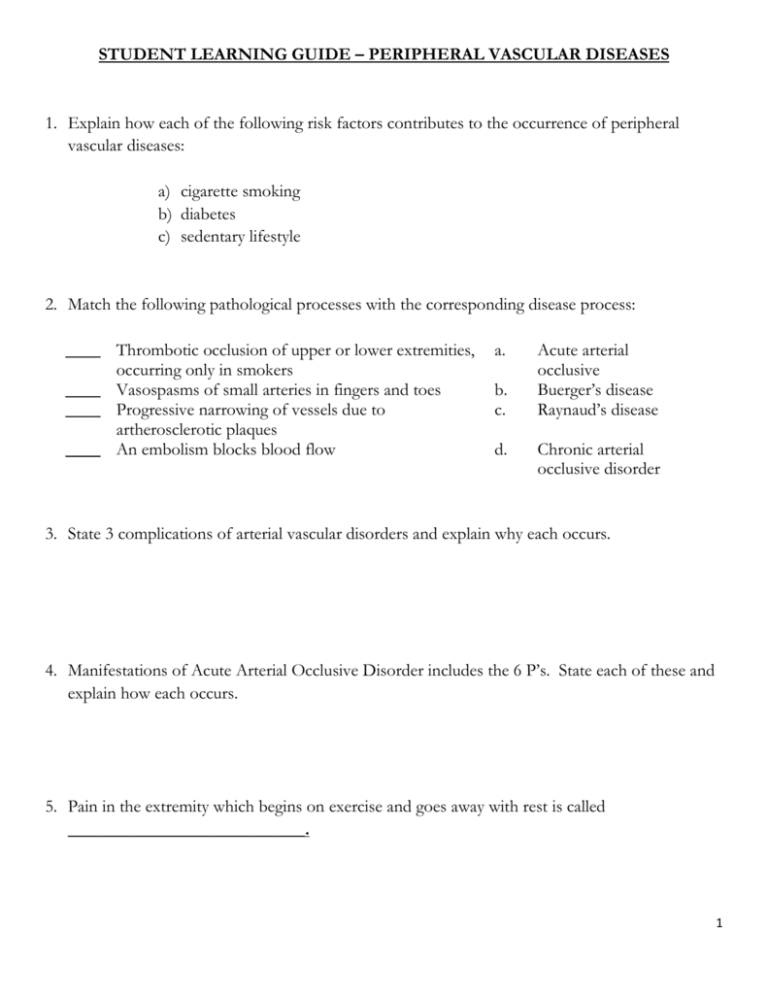
STUDENT LEARNING GUIDE – PERIPHERAL VASCULAR DISEASES 1. Explain how each of the following risk factors contributes to the occurrence of peripheral vascular diseases: a) cigarette smoking b) diabetes c) sedentary lifestyle 2. Match the following pathological processes with the corresponding disease process: ____ Thrombotic occlusion of upper or lower extremities, occurring only in smokers ____ Vasospasms of small arteries in fingers and toes ____ Progressive narrowing of vessels due to artherosclerotic plaques ____ An embolism blocks blood flow a. b. c. d. Acute arterial occlusive Buerger’s disease Raynaud’s disease Chronic arterial occlusive disorder 3. State 3 complications of arterial vascular disorders and explain why each occurs. 4. Manifestations of Acute Arterial Occlusive Disorder includes the 6 P’s. State each of these and explain how each occurs. 5. Pain in the extremity which begins on exercise and goes away with rest is called ___________________________. 1 6. You are conducting an assessment on a client with chronic arterial occlusion. Check all of the following manifestations that you would expect to find. ___ ___ ___ ___ ___ ___ ___ ___ Severe and constant pain, not relieved by rest Intermittent claudication Poikilolthermia Thickened, brittle nails Paralysis Decreased or absent peripheral pulse Red rubor Ischemic muscle ache 7. Indicate whether the following manifestations are characteristic of Buerger’s disease or Rayaud’s phenomenon? ___ ___ ___ ___ ___ ___ ___ ___ ___ ___ Involves cutaneous arteries of the fingers and toes Inflammation of midsized arteries and veins Treated with calcium-channel blockers, especially Procardia Strongly associated with smoking Predominant in young females Episodes involve white, blue, and red color changes of the fingertips Amputation of digits or legs below the knee may be done due to ulceration and gangrene Precipitated by exposure to cold, caffeine, and tobacco Intermittent claudication of feet, arms, and hands may be present Frequently associated with autoimmune disorders 8. A client with Raynaud’s disease may present with extremities that turn red, white and blue. In what order due these colors occur and why? 9. Describe the following tests for diagnosis of peripheral arterial disease. a) b) c) d) Angiography Segmental Pressure Readings Stress Testing Treadmill Doppler Ultrasonography 2 e) Duplex Doppler Ultrasonography f) Transuctaneous Oximetry 10. Below is a list of nursing diagnoses. Some, but not all of them apply to a client with Arterial Vascular Disorders. Place a number in the blank indicating the priority for all of the diagnoses that apply. _____ _____ _____ _____ _____ _____ Pain r/t vascular pooling Activity intolerance r/t imbalance between oxygen supply and demand Impaired skin integrity r/t decreased perfusion and decreased sensation Pain r/t ischemia Altered tissue perfusion: peripheral r/t effects of arterial spasm or arterial occlusion flow Impaired skin integrity r/t valve incompetence 11. Indicate whether the following treatments apply to peripheral arterial or venous disorders? ___________ ___________ ___________ ___________ ___________ ___________ a) b) c) d) e) f) Sympathectomy Bypass graft Thrombectomy Insertion of a Greenfield filter Vein ligation Sclerotherapy 12. State 5 appropriate goals for a client with Arterial Vascular Disease. 13. Match the following descriptions with the appropriate surgical therapy: _____ _____ _____ Used to decrease neurological stimulation to vessel Cage expanded in the vessel Catheter inserted with a balloon a. Embolectomy b. Endarectomy c. Arterial bypass 3 _____ _____ Graft to replace an occluded artery Vessel dissected to remove clot d. Sympathectomy e. Intravascular stent f. Percutaneous translulminal angioplasty 14. You are caring for a client who has just had a stent placement in the left femoral artery. What should you assess during the first 48 hours post-op? What complications should you assess for? 15. Match the following items with the appropriate medication: _____ _____ _____ _____ _____ _____ _____ Interferes with vitamin K Increases erythrocyte flexibility Acts directly on the intrinsic pathway Low molecular weight heparin Prevents aggregation of platelets Breaks down existing clots Enhances blood flow by increasing vessel lumen size a. b. c. d. e. f. g. Vasodilators Urokinase Coumadin Heparin Lovenox Trental Plavix 16. Create a teaching plan for clients with each of the following diagnoses: a) Raynaud’s disease b) Thromboangitis Obliterans (Buerger’s Disease) c) Chronic Arterial Occlusive Disease (Atherosclerosis Obliterans) 4 17. What exercises would you recommend to a client to help promote peripheral circulation? 18. Identify which of the following is true or false. ____ ____ ____ a) The most common cause of superficial thrombophlebitis in the legs is IV therapy. b) A tender, red, inflamed irritation along the course of a peripheral vein is characteristic of a deep vein thrombosis (DVT). c) The method of prevention of DVT in hospitalized patients that addresses all three parts of Virchow’s triad is the use of elastic compression stockings. 19. State 3 factors that contribute to the occurrence of thrombophlebitis and give 2 examples of conditions that could cause each factor. (Virchow’s triad) 20. What is Virchow’s triad? 21. How do you prevent embolization of a thrombus in the patient with a DVT? 22. Explain how venous stasis ulcers occur. 5 23. How does each of the following contribute to the formation of varicose veins? a) Obesity b) Pregnancy c) Prolonged standing 24. Describe the following tests for the diagnosis of peripheral venous disease. a) b) c) d) Venous Ultrasonography Plethysmography MRI Ascending Contrast Venography 25. Identify reasons to notify the physician immediately after a femoral-popliteal bypass? 26. List four nursing interventions for a post-op femoral-popliteal bypass patient. 27. Indicate whether the following findings are manifestations of arterial (A) or venous (V) disease. _____ _____ _____ _____ _____ _____ _____ _____ _____ _____ _____ a. b. c. d. e. f. g. h. i. j. k. Parathesia Heavy ulcer drainage Edema of the ankles Gangrene over bony prominences on toes and feet Decreased peripheral pulses Brown pigmentation of the legs Thickened, brittle nails Pallor on elevation of the legs Rubor when legs are dependent Dull ache in calf or thigh Pruritus 6 28. You are providing care for a client with Deep Vein Thrombosis and are assessing for signs and symptoms of pulmonary embolism. What signs or symptoms would occur first? 29. Describe the treatment for pulmonary embolism. 30. Which of the following clinical manifestations would you expect to find for a client with Deep Vein Thrombosis? ______ ______ ______ ______ ______ ______ Intermittent claudication – found in arterial disorders Positive Homan’s sign Ulceration of the toes – arterial disorders. Ulceration of ankles for venous Swelling – around ankles and lower leg Brown, leathery skin Cyanosis of the extremity – if dependent 31. Complete the following table for each of the anticoagulants indicated: Medication Coagulation Study Normal result without treatment Heparin Expected therapeutic result with treatment Coumadin Lovenox 32. Decide which of the anticoagulant drugs, unfractionated heparin, low molecular weight heparin, or coumadin, applies to the following: ____________________________ ____________________________ ____________________________ ____________________________ a) b) c) d) Vitamin K is the antidote Is only administered subcutaneously Routine coagulation tests are not usually required Protamine sulfate is the antidote 7 ____________________________ ____________________________ ____________________________ ____________________________ ____________________________ e) f) g) h) i) May be administered IV or subcutaneously Is only administered orally International normalized ratio is monitored Partial Thromboplastin Time (PTT) is monitored Prothrombin Time (PT) is monitored 33. The antidote for Heparin is _________________________. 34. The antidote for Coumadin is ________________________. 35. Why must the intake of leafy green vegetables be consistent for a client on Coumadin? 36. State 3 appropriate goals for a client with a venous disorder. 37. Beside each of the following nursing interventions indicate whether the intervention is appropriate for either an arterial (A) or v (V) disorder. ______ ______ ______ ______ a) b) c) d) Elastic compression stockings Walk to the point of pain Wear clothing to keep the extremity warm Elevate the extremity 8

